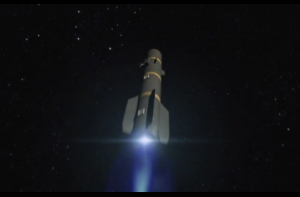One of the themes I will be exploring over the next few weeks is apocalypse prediction movies, and while it may seem logical to start with the biggest one, at least from the recent past, I’m instead going to start with an astronomical flare (pun unfortunately intended). 2012: Supernova is our first entry in a cavalcade of 2012 movies, though this one is unique in a couple of ways. First, it has nothing to do with the Mayan apocalypse. Second, it’s about a supernova! Finally, some real astronomy to dig our teeth into. This is a long one, so if you don’t read the whole thing, please skip to the last couple of paragraphs because they’re important.
200 light years away, in the constellation Lyra, a massive star goes supernova. Stop! Stop the film right there! I know we’re only at the 23 second mark, but I can’t let that go past. Let’s talk about supernovas for a minute. In order to understand supernovas, you first must understand one basic thing about stars. Stars exist in a beautiful equilibrium state: gravity is trying to collapse the star smaller and smaller, while energy released by nuclear fusion in the core of the star is pushing outwards, supporting the star. This perfect balancing act is one of the most astounding feats in nature. Stars, especially low-mass ones like the Sun, can exist happily in this state for billions of years. However, there is a limit to the amount of fuel (hydrogen) available in the cores of stars. Once the fuel is used up, the star can no longer support itself against the crushing attraction of gravity, and (great oversimplification here) bad things happen.
The particular variety of bad thing depends on a number of factors, including the star’s mass, its composition, and whether it exists in a close binary star system. I don’t want to get bogged down in the details of the different varieties of supernovas here. That’s what the wikipedia is for. Most supernovas share one important trait in common: the energy released in the explosion in the form of electromagnetic radiation is, and again this is a drastic oversimplification, approximately constant. And it’s a LOT. A supernova 200 light years from the Earth could certainly have negative consequences. The most dangerous potential consequence is depletion of the ozone layer, which would increase our exposure to solar and cosmic radiation. This would be very bad, and has even been proposed as one of the potential causes of the Ordivician-Silurian mass extinction.
“Sounds like the movie’s off to a great start,” you say. Not so fast! There are no known supernova progenitors in the direction of Lyra, at least within many times the potential danger distance. The nearest known candidate is IK Pegasi, which is 150 lightyears away in (as the name implies) Pegasus. “What about unknown candidates?” I’m glad you asked. There are two main types of supernova progenitors. The first type are incredibly massive stars near the ends of their lifetimes. These are very easy to detect, because massive stars are bright and incredibly rare. Astronomers have a fairly complete list of the stars likely to lead to this variety of supernova, the nearest of which is Alpha Lupi, around 500 lightyears away. The second type are white dwarfs that exist in close binaries with other stars. These are very difficult to detect until they explode, and result in what are called Type Ia supernovas. IK Pegasi is a candidate of this type. It’s actually the only known candidate within a couple thousand lightyears (the danger zone), but again these are hard to detect.
“So what’s your problem? The supernova in the movie could be one of these Type Ia things, right?” Nope. The movie clearly shows a massive blue star exploding. No binary. Although it does have a planet, which is potentially problematic for other reasons. In any case, it’s not hard to look up a list of nearby supernova candidates and just pick one of those to include in your movie.
Back to the film. The Spitzer Space Telescope tells us that there will be enough gamma radiation “for a planet-killing catastrophe”. Two problems here: 1) Spitzer is an infrared telescope, so doesn’t know jack about gamma rays. 2) Gamma rays are light. Light travels at the speed of light. Most of the energy from a supernova is released in a few seconds, so by the time you know about it, the damage is done.
But if we assume there’s some sort of delay, with an initial small shock front followed by waves of destruction, we can at least make it 15 minutes into the film to discover the plan. Oh you better believe it involves nukes. Our hero intends to beef up the Earth’s magnetosphere by setting off a bunch of nukes, but the scientists have a raging debate over whether to set them off inside or outside the magnetosphere. Unfortunately, the nukes can’t be launched from Earth–they have to be launched from a space platform where they can be controlled “without the Earth’s gravitational pull.”

I’m going to ignore some ridiculously bad science that’s completely unrelated to the plot because I really do have a soft spot for these terrible movies, and any movie that makes me laugh, albeit unintentionally, gets somewhat of a free pass. Also I’m over 800 words into this commentary and only 24 minutes into the movie.
The shuttle needs to launch a last load of nukes up to the weapons platform if there is any hope of saving humanity. The scientists have detected how long it’ll be before the next shockwave reaches Earth, so liftoff! Except they were off in their calculations and the next wave hits the shuttle, causing it to break up in a remarkably similar fashion to the unbelievably tragic breakup of the space shuttle Columbia in 2003. They actually used real video footage of it! This movie’s free pass has now expired. Time to nitpick it to death, starting with the pronunciation of the word “magnetosphere”. (Rhymes with “neat”, not “net”.) Ah well, at least they didn’t say “nukular”.
So the hero’s wife and daughter are driving through the desert in a terrible supernova-induced lightning storm. The daughter points out that the car will act like a Faraday cage and keep them safe. Until the window breaks. Then “the Faraday cage is broken. The electricity can get us now.” Ok film, I’ve had enough. Anyone who knows anything about electricity knows that glass is an incredible insulator. In fact, it’s just about as perfect an insulator as exists in the world. If lightning hits the car, the electric charge will pass through the car’s metal frame, since metal is a good conductor. Electricity, like water, follows the path of least resistance. The glass window has absolutely nothing to do with the car acting as a Faraday cage. See, this is the stuff that drives me nuts. If you’re going to include a very basic scientific concept and describe it correctly, then use it correctly. Come up with a reason for there to be some exposed metal in the car or something.
Then they get out of the car because “it attracts lightning”, but the hero’s daughter says “Stay away from the trees! They attract lightning the most!” Wow. Just… wow. You know, most lightning is ground to cloud or cloud to cl… you know what? Never mind. Let’s keep going.
Finally we see a scene of the devastation headed our way. It’s a bunch of rock fragments, presumably from the aforementioned planet, inside a beam of light headed straight for Earth. So are the rocks traveling at the speed of light? Or is the light coming from hot gas that’s traveling at the same speed as the rocks? We’re told repeatedly that gamma radiation is the problem, so why the rocks?
The hero makes it to the orbital weapons platform, which has Earth-like gravity despite lack of rotation. He manages to launch the nukes, which have fins. Why do missiles have fins? For stability in the atmosphere. A nuke launched from an orbital platform could be whatever shape you wanted. Of course, the plan works and the hero saves the day.

Before wrapping up, I want to make it clear that there’s a reason I comment on these made-for-TV movies. It’s not that I expect them to meet the same standards as big studio productions, in terms of writing, production value, or even scientific accuracy. It’s that the science portrayed in these films is severely flawed, and those flaws point to a huge lack of scientific literacy, both on the part of the filmmakers who put in scientific misconceptions, and on the part of the audience who accepts or ignores them. It’s not that every film needs to be 100% accurate. But films need to establish a believable universe in which they take place. Otherwise, the audience is unable to suspend disbelief when the plot requires. I’m not asking the filmmakers to take a course on stellar astrophysics, but if your film is about a supernova, you could, at the very minimum, read the wikipedia article on supernovas.
In the case of this film, most of the action isn’t even about the supernova. The wife and daughter are in peril and we see them barely escape from some dangerous situations. Meanwhile, the hero is nearly thwarted by bad guys who want the nuclear defense shield to be centered over Asia, thus giving people in that part of the world a better chance of survival. So not only would it not ruin the film to improve the science, it would be almost inconsequential to the plot! Think about all the work that goes into making even a made-for-TV movie. There’s casting, wardrobe, location scouting, stunt people, craft services. How much extra work would it be to hand the script to a scientist and have them give it a quick once-over? In fact, I’ll volunteer. Any producers of sci-fi movies or TV shows: I will read your script for free and give you advice on how to make it look like you didn’t flunk 8th grade physical science. Then, if you take my suggestions, I will buy your movie the day it’s available watch your movie on Netflix.


